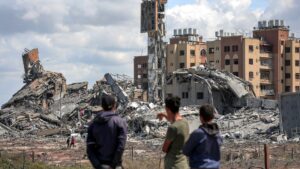While eyes are on Rafah, Israel is cementing control of northern Gaza

Youths watch as people search the rubble of destroyed buildings in the Asra residential compound, northwest of Nuseirat, Gaza , on 25 March 2024
Ameer Makhoul writes in Middle East Eye on 25 March 2024:
Following his recent approval of a plan to invade Rafah – where 1.4 million Palestinians are sheltering – Israeli Prime Minister Benjamin Netanyahu announced last week that the military is preparing to advance.
The so-called “triumvirate” war cabinet comprising Netanyahu, Defence Minister Yoav Gallant, and former opposition leader Benny Gantz, had already reached a consensus on a Rafah incursion to take control of the Philadelphi corridor (also called the Philadelphi route or Saladin axis).
In an address to the US pro-Israel lobby group AIPAC, Netanyahu insisted that the “road to victory runs through Rafah”, a strategy that he boasts has “overwhelming support” within Israeli society.
Yet, while Israeli politicians’ threats of an imminent invasion of Rafah are directing the world’s attention to the south, the government has accelerated steps on the ground in northern Gaza to consolidate its occupation and ensure its longevity.
A key feature of its strategy is to prevent the return of displaced Palestinians from the south as it seeks to change the geographical and demographic characteristics of the Gaza Strip.
‘Permanent occupation’
Satellite imagery analysed by CNN shows that a road being built by the Israeli military to split Gaza in two has reached the Mediterranean coast.
According to the CNN report, a satellite image from 6 March “reveals that the east-west road, which has been under construction for weeks, now stretches from the Gaza-Israeli border area across the entire roughly 6.5km-wide (about 4 mile-wide) strip, dividing northern Gaza, including Gaza City, from the south of the enclave.”
The report notes that the military used a “large amount of mines and explosives” to clear the area. The American-made bombs were used to destroy the remaining homes and infrastructure throughout northern Gaza, particularly in the Beit Hanoun area, which borders the Erez crossing.
Other areas near Gaza City, especially in its eastern suburbs, have become part of the buffer zone that Israel is building in Gaza and along the border.
In the Zaytoun neighbourhood, amid never-ending ceasefire negotiations, the Israeli military is making progress in a civilian management “pilot project” intended to fully control the distribution of food and other provisions. It is based on the belief that whoever controls the food controls the people.
This project is accompanied by Israel’s strict ban on aid to Gaza and the expulsion of humanitarian organisations from the area, a policy it seeks to expand to other areas of Gaza. Israel has specifically targeted and aims to destroy the UN agency for Palestinian refugees, UNRWA, as part of its efforts to eliminate the refugee issue and the Palestinian right of return.
